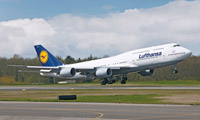News Backgrounder
The quiet achiever. The B747-8I slips into service with little fanfare
While brand new aircraft types such as the A380 and B787 Dreamliner grabbed the headlines when they flew for the first time, the latest version of Boeing’s jumbo jet, the B747-8, has slipped into commercial service with little fanfare. But it is performing better than expectations.
May 1st 2013
Boeing may only have orders from four airlines for the passenger version of its latest jumbo jet, the B747-8 Intercontinental, but Bruce A. Dickinson, vice-president and chief project engineer of the B747-8 programme, is convinced that will improve this year. And he believes Asia-Pacific airlines will lead the charge to sign up for the plane. Read More »
 |
| 'We believe many operators have been in a wait and see mode. We are optimistic' |
| Bruce A. Dickinson Vice-president & Chief Project Engineer B747-8 Programme |
“This airplane, particularly with some of the changes we are making and the range it can fly, is nicely suited for [the Asia-Pacific] region. The fact that Air China and Korean Air are the passenger operators is why we think the opportunities are incredibly strong in this region.” Each carrier has ordered five B747-8Is.
Dickinson predicted a lot of sales activity now the aircraft has been flying with launch customer, Lufthansa, for almost a year. “I know you will see order numbers change this calendar year. We know that for sure on the passenger side,” he said.
“We believe operators have been in a wait and see mode. Many of our B747 operators are facing the decision of what to do with their 747 retirements. We are optimistic.”
Lufthansa, which ordered 19 of the new passenger jets and has six in service, began commercial operations last June with flights to Washington. It later added New Delhi, Bangalore and Los Angeles. Its first Intercontinental service into Asia, from Frankfurt to Hong Kong, started last month.
Korean Air and Air China’s planes will be delivered from 2014. The only other carrier to order the passenger version of the B747-8 is Nigeria’s Arik Air, which will take two of the jets. Another nine have been ordered by un-named customers listed as “business jet/VIP”.
Dickinson said the Intercontinental “probably doesn’t have the flash of what some marketeers do with brand new aircraft types. But we believe our flash is the bottom line: the revenue it generates, amazing improvements over our previous B747s and better performance.”
Indeed, the B747-8 has exceeded all expectations in service at Lufthansa. It is, essentially, a completely new aircraft.
It has a new wing with raked wingtips that offer improved aerodynamics. It has newly developed GEnx-2B67 engines that use the same technology as the B787 Dreamliner’s engines.
 |
| The B747-8 Intercontinental: entry into service has been better than the “gold standard” B777 entry into service |
The ailerons and flaps are controlled by fly-by-wire technology, which reduces maintenance costs. New aluminium alloys improve corrosion resistance and reduce overall weight. The interior of the aircraft also is significantly different to the B747-400, incorporating Dreamliner design features.
Originally, the B747-8 was designed to have a maximum take-off weight of 975,000 lbs, but after the success of flight testing this was raised to 987,000 lbs, about 100,000 lbs more than the -400.
The Intercontinental is 15% more fuel efficient than comparable long-range aircraft, generating 15% fewer emissions and with a noise footprint about 30% smaller than the B747-400. Best, of all, said Dickinson, there were more improvements to come.
“We are continuing to bring the overall weight down, in some cases through the introduction of composites, but in many cases with refinements in every area of the aircraft.”
Later this year, there will be improvements to the engines. Boeing is certifying the latest flight management computer to allow for many operational efficiencies, such as optimizing climb and arrival profiles, to save additional fuel. Greater drag reduction activities are also to be developed.
“We have a target of an additional 2% saving of fuel, which is a big number on top of what is already flying today,” said Dickinson.
He believes the aircraft’s size is another big plus. The A380 is officially a 555-seat aircraft with its next largest the yet-to-enter-service A350-1000 at 344 seats, said Dickinson, leaving a 200 seat gap between models.
Boeing has the B777-300ER at 386 seats, the now out-of-production B747-400 at 416 seats and the stretched B747-8 at 467 seats. “We like where we are positioned with our size,” said Dickinson.
The B747-8 was the first time Boeing started a major aircraft programme with a freighter. Previously, it had always had what it called a “freighter later” programme. Some 70 B747-8 freighters have been sold and all of those operating are flying into the Asia-Pacific region.
“We have enjoyed a terrific transition into service for both freighters and passenger aircraft,” said Dickinson. “One of the measures we use is dispatch reliability. We have bettered our target.
“The gold standard was the B777 entry into service. We have performed even better than the B777 did.
“One thing we are proud of is that the freight guys took the plane and they didn’t baby it into service with simple routes. They just loaded it and went. Utilization was great right out of the gate.”
| Production rate cut Despite Dickinson’s optimism, at press time last month Boeing announced it was cutting the production rate for the B747-8 from two aircraft per month to 1.75 aircraft, citing lower demand for large passenger and cargo planes. The manufacturer has a backlog of 64 B747-8s, with seven orders in 2012 and three orders to date in 2013. Boeing said it expected long-term average growth in the air cargo market to resume in 2014 and still forecasts a demand for 790 large aircraft, such as the B747-8, to be delivered worldwide in the next 20 years. |